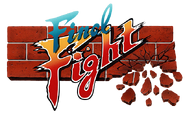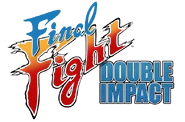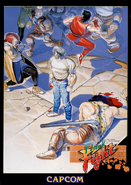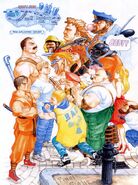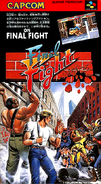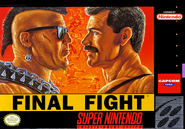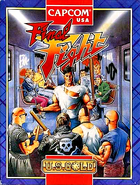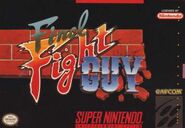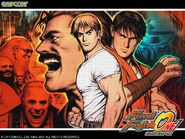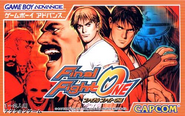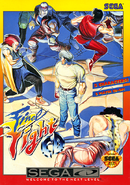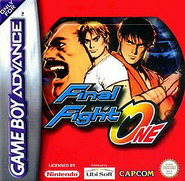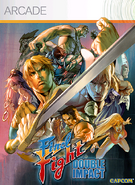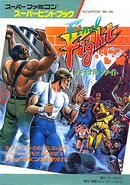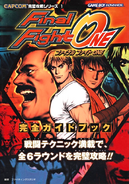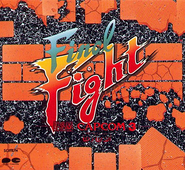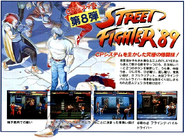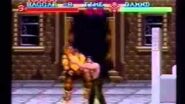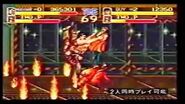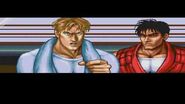Final Fight (ファイナルファイト Fainaru Faito?), released in 1989, is the first game in the Final Fight series. It is considered to be a "cousin" of Street Fighter, and the two series are set in the same universe.
Final Fight was originally released as an arcade game and was ported to several platforms, including the Super Nintendo Entertainment System, Sega CD, Sharp X68000 and Game Boy Advance (as Final Fight One). It is also included in Capcom Classics Collection.
Story
The story of Final Fight takes place from within the fictional city of Metro City, in which both crime and violence has ruled the streets for many years and that the citizens themselves live in a complete state of constant fear and danger at the hands of the local street gangs, which has given Metro City an infamous reputation in being a well-known crime capital of the world. A former professional wrestler and street fighter turned newly-elected mayor, named Mike Haggar had made a personal vow to the public from within his past campaign in that he would help clean up the streets of both crime and violence so that the citizens of Metro City could finally gain the peace and happiness that they had sought and wanted for so long.
The Mad Gear Gang: the most powerful and dominant criminal organization of Metro City's criminal underworld, sees Haggar as a potential threat to their own violent rule of the city, which causes the gang to create and initiate an immediate plan of action so that they could make sure and see to it that Haggar himself doesn't get in the way of their own criminal activities. While in his office one day, Haggar receives an unexpected phone call from a suspicious sounding man who tells him that his young daughter, Jessica has been kidnapped by Mad Gear and he also warns Haggar that unless he doesn't want anything bad happening to her, he'll let the gang do as they please like the last mayor did before him. Upon knowing and realizing the dire threat at hand, Haggar wastes no time in meeting up and informing both his daughter's boyfriend Cody and his sparring partner Guy about the entire situation, which causes Cody and Guy to know and realize the fact that they can't allow Mad Gear to get away with this and that the two of them personally vow to aid and help Haggar out in saving Jessica and defeating Mad Gear.
From there, the trio of Haggar, Cody, and Guy head into the streets of Metro City to bust Mad Gear's skulls, fighting their way through the hordes of goons littering the city and also battling against the top ringleaders of Mad Gear, which includes the Caribbean thug Damnd, the American Japanophile Sodom, the corrupt cop Edi. E, former Red Beret and militia leader Rolento, and the ill-tempered Abigail. After fighting and battling against all of Mad Gear from within their rescue mission, Haggar, Cody, and Guy soon confronts the Mad Gear's boss and leader, the crooked businessman Belger from upon the top floor of a large building which serves as Belger's penthouse apartment. After a tough and intense final fight, Cody knocks Belger out of the window with a strong uppercut punch, sending him falling to his death below while Jessica is rescued and saved from the current danger, culminating with Cody and Jessica sharing a passionate kiss with each other as the young couple are emotionally happy to be reunited with one another after the entire ordeal.
The original Japanese version of the Final Fight intro states that the game takes place in 1989, and provides the corresponding ages and birthdates for each of the main characters. The English language version changes the setting to "Sometime in the 1990s..." and only provides the birthdates for the characters. The English translation featured in Final Fight One reverts back to the original 1989 date.
Gameplay
Final Fight can be played by up to two players simultaneously, with each player controlling a different character. Before the game begins, the player chooses between the three main characters, Guy, Cody, and Haggar, each with his own fighting style and attributes. Guy is the weakest but has faster attacks, Haggar is the strongest but also the slowest, and Cody has all-round attributes.
The controls consists of an eight-way joystick and two buttons for attacking and jumping. The player character can move in any of the eight directions, but can only face and attack to the left or right like in most beat-'em-ups. Pressing both buttons simultaneously performs a special move that attacks in both directions, though it uses a little vitality. Players can also grab and throw opponents, as well as use various weapons such as knives, pipes, and swords.
Levels
Final Fight consists of six stages or "rounds", as well as two bonus rounds. Each round takes place in a different section of Metro City such as the Slums and the Subway, with most rounds featuring more than one level. At the end of each round, the player will face a boss character unique to that round. The rounds and bosses are:
- The Slums (Damnd)
- The Park/Subway (Sodom)
- The West Side (Edi. E)
- The Industrial Area (Rolento)
- The Bay Area (Abigail)
- Uptown (Belger)
Differences Between Versions
SNES
On the Super Nintendo home console version, the game underwent some extreme changes. The list below addresses the major ones:
- Co-op mode was removed, rendering the game a one-player experience.
- Two major characters, Guy and Rolento, were taken out, altering almost the entire storyline.
- The only female characters in the game, Poison and Roxy, were replaced by Billy and Sid, for censorship reasons.
- In the English localization, Sodom and Damnd were renamed Katana and Thrasher.
- Belger's wheelchair was redrawn to look like he was sitting in an office chair, and thus not handicapped.
- Bred screaming "Oh My God!" was changed to "Oh, My Car!" after he discovers his car has been destroyed.
- Blood and alcohol was removed entirely.
Commodore Amiga
Released in 1991, this home computer version contained several changes from the arcade game, some game-changing. The major ones listed below:
- Wong Who renamed to Wong Hu.
- Alcohol removed, as well as katanas.
- No scene with Bred after the car is destroyed.
- Elevator stage and Rolento boss fight completely removed.
- Abigail boss fight removed, Abigail's sprite replaces Andore Jr's.
- Belger referred to as 'Boss' on his damage bar, he remains in his wheelchair for the entire fight.
Sega CD
The Sega CD home console version, while retaining nearly all the features of the arcade game which were removed in the SNES port, still had Poison and Roxy wearing less-revealing clothes. The graphics, while considerably closer to the arcade version, nonetheless suffered from inferior coloring and fewer details in the backgrounds. On the plus side, the CD version contained a time-attack mode and voice acting was added to the game's cut-scenes. Whether the re-arranged music and voice acting featured was a good thing or not, is, of course, a matter of taste.
Final Fight Guy
Since the SNES release of Final Fight excluded Guy, Capcom revised it and released Final Fight Guy in 1992 on the SNES. This time, Cody was excluded from the roster, and the player could only choose between Guy and Haggar. The beginning of the story states Cody is in Japan.
In 1994, Final Fight Guy was released in the U.S. and was a rental-only game available at Blockbuster stores.
Final Fight One
The Game Boy Advance version, titled Final Fight One, was released in 2001 as one of the earliest games for the system. Final Fight One features all three characters and the Industrial Area stage that was missing from the SNES version. Dialogue exchanges prior to each boss battle have been added, and the Street Fighter Alpha renditions of Cody and Guy are featured as hidden characters.
Final Fight: Double Impact
In April 2010, Capcom released Final Fight: Double Impact, which featured Final Fight as well as their side-scrolling fantasy-themed beat-em-up Magic Sword. Both games received an HD graphics boost in the form of upscaling combined with graphics filters. The downloadable release featured both classic visuals and a new visual mode that displayed the games in HD. Both games also supported leaderboards and drop-in online co-op play.
Trivia
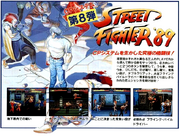
Flyer displaying the game's original planned name
- Final Fight was originally going to be the sequel of the original Street Fighter. The working title for the game was Street Fighter '89. The game was announced in Japanese magazines with the name Street Fighter: The Final Fight in March 1989.
- Guy and Sodom were featured as playable characters in the original Street Fighter Alpha released in 1995 with Sodom trading his katana blades in favor of a pair of jitte. Rolento was then added to the playable roster in 1996's Street Fighter Alpha 2, followed by Cody in 1998's Street Fighter Alpha 3, who was reimagined as an escaped convict. Also in Alpha 3, if Sodom is selected under the X-ISM system, he will fight with a pair of katanas again.
- In Guy's stage in Street Fighter Alpha 2, all the characters from Final Fight make cameo appearances in the background such as Cody, Haggar, Jessica, Poison, and Hugo.
- Final Fight One is the only version of Final Fight that includes dialogue sequences with the player characters and the current stage boss. It has minor character color change options, a Sound Test to listen to the game's soundtrack and voice clips, a Stage Select and Starting Lives feature, the ability to play as the Alpha versions of Guy and Cody, and an option to use rapid attacks.
Gallery
Promotional Art and Packaging
Video
External Links
- Final Fight One Official Japanese Site (archive)
| Final Fight series | ||||
|---|---|---|---|---|
| Main | Final Fight (CD · One · Double Impact) · Final Fight 2 · Final Fight 3 | |||
| Spin-offs | Mighty Final Fight · Final Fight Revenge · Final Fight: Streetwise | |||

